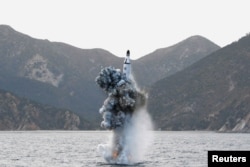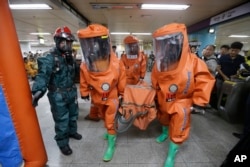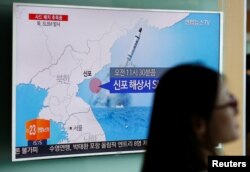After North Korea launched a ballistic missile from a submarine off its east coast early Wednesday, regional leaders and the U.S. condemned the test, with Japan's prime minister calling it "unforgivable."
The missile, which was launched from near Sinpo about 5:30 a.m. local time Wednesday (2030 UTC Tuesday), flew about 500 kilometers over and into the Sea of Japan. It was the latest in a series of missile launches in defiance of U.N. Security Council sanctions.
Japan Prime Minister Shinzo Abe said, in a first, that the missile entered Japan's air defense identification zone.
"This poses a grave threat to Japan's security and is an unforgivable act that damages regional peace and stability markedly," Abe said. He added that Tokyo had lodged a protest against North Korea.
U.S. Strategic Command (USSTRATCOM) said the launch was of "a presumed KN-11 submarine launched ballistic missile."
"We strongly condemn this and North Korea's other recent missile tests, which violate U.N. Security Council resolutions explicitly prohibiting North Korea's launches using ballistic missile technology," said a statement by the U.S. agency.
The launch came amid growing regional concerns about North Korea's missile and nuclear programs. Rocketry experts told Reuters news agency that the distance the missile traveled indicates the North is improving its submarine-launched missile system.
"I think it was probably successful," Jeffrey Lewis, of the California-based Middlebury Institute of International Studies, told Reuters. "We don't know the full range, but 500 kilometers is either full range or a full range on a lofted trajectory. Either way, that missile works."
The incident also occurred on the same day the foreign ministers of China, Japan and South Korea are scheduled to meet in Tokyo.
It also came one day after South Korea and the United States began their annual joint military exercises. About 25,000 U.S. forces and 50,000 South Korean troops are involved in the two-week Operation Ulchi Freedom exercise, which is largely simulated.
North Korea threatened military retaliation. A statement issued Monday by the North's military said its first-strike units were ready to turn the United States and Washington "into a heap of ashes through a Korean-style preemptive nuclear strike," if North Korea's sovereignty was threatened.
Both South Korea and the U.S. insist the exercises are purely defensive in nature.
On Tuesday, the United Nations Command said North Korea has been laying new land mines on its side of its heavily fortified border with South Korea.
North Korean soldiers have been spotted planting anti-personnel mines on its side of the so-called Bridge of No Return, a river crossing near the border truce village of Panmunjom.
The U.N. Command, which oversees the cease-fire that ended the 1950-53 Korean War, condemned Pyongyang in a statement released Tuesday, saying it "seriously jeopardizes the safety of people on both sides" of the Demilitarized Zone.
North Korea has been blamed for planting land mines along the DMZ that detonated last year, maiming two South Korean soldiers patrolling the border.
The U.S.-led command would not speculate on why North Korea is taking such action, but South Korea's Yonhap news agency said it was told by a government source that the mines are there to prevent front-line North Korean troops from defecting.












